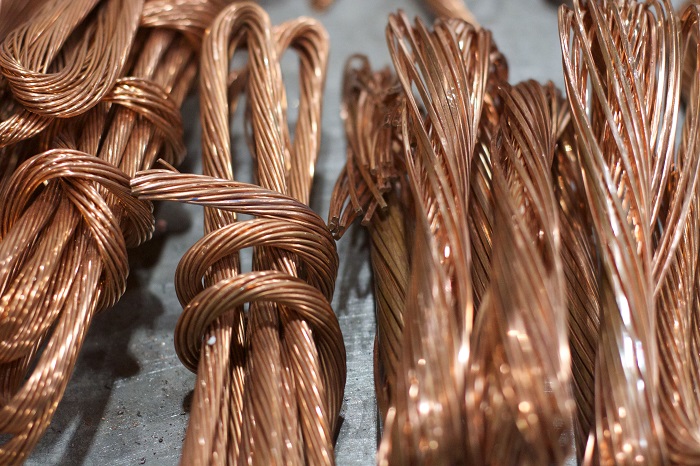ISABEL RUBIO ARROYO | Tungsteno
While copper is essential for making mobile phones, lithium is used for electric car batteries, boron for microprocessors and tungsten for turbine propellers. Some devices would not exist (at least as we know them today) without these materials. We investigate which chemical elements are key to making the most promising devices and technologies on the planet.
"I think most people do not have any idea of the range and scale of metals and minerals that are used to make electronics," says Richard Herrington, Head of Earth Sciences at the Natural History Museum in South Kensington, London. He is referring to all those elements that are used to make everything from computers to mobile phones, vehicles, wind turbines and solar panels. That "technology that we didn't have 15 or 20 years ago that we now take for granted."
Copper
More than 30 different minerals are used to make a mobile phone, for example. "The content of copper in a mobile device far exceeds the amount of any other metal," says the US Geological Survey. This element, used for millennia to make primitive tools, comes from the mineral source chalcopyrite, although it can also be found in other minerals such as bornite and chalcocite. Its high electrical and thermal conductivity makes it ideal for the electrical wiring of many other devices such as hydroelectric turbines. Currently, Chile, Peru and China are the largest producers of copper.

Copper is a reddish metal noted for its high electrical and thermal conductivity. Credit: Pxhere
Lithium
"Lithium ion batteries power almost all electric vehicles available, as well as most personal electronic devices," notes Geoscience Australia. This element, in addition to marking a breakthrough in electric mobility, is used to store energy generated from solar and wind technologies. Sourced mainly from Chile and Argentina, it can be extracted from lithium chloride salts found in brine pools, as reported by the Geological Society of London. As the amount of lithium available in nature is limited, manufacturers themselves see a need to recycle it within the context of the emergence and growth of the electric vehicle market.
Chile is a major producer of lithium, a key element used to make electric batteries. Credit: Bloomberg Quicktake.
Boron
From microprocessors to the camera chips in mobile phones and the coatings used to protect their touchscreens, these are just a few examples of the many devices whose manufacture requires borax, a mixture of boron-containing minerals. This chemical element is also used in semiconductor devices such as integrated circuits and capacitors. Among its qualities, it helps to form layers on metal that protect devices against corrosion and provides structural support and insulation. Turkey and the United States are the largest global producers of boron.

Boron is a chemical element useful for making the microprocessors and chips in mobile phone cameras. Credit: James L Marshall / Wikimedia Commons
Tungsten
Tungsten, another key element in some technological devices, is twice as dense as steel and four times harder than titanium. Together with cobalt and neodymium, it makes our phones vibrate. "All three elements are used in the small but heavy mass that is spun by a motor inside our phones in order to create vibrations," explains Hywel Jones, a materials researcher at Sheffield Hallam University, in The Conversation. As well as being used in the manufacture of high-performance steels, combined with carbon it "creates an extremely hard ceramic for cutting tools used in the machining of metal components in the aerospace, defence and automotive industries." The alloys of this element, which comes mainly from China, are good conductors of electricity and are also used in X-ray tubes and turbine propellers.

Tungsten is present in mobile phones, X-ray tubes and turbine propellers. Credit: Alchemist-hp / Wikimedia Commons.
"It is really important that we all understand where the raw materials come from, that metals and minerals are in the Earth where nature puts them. They don't come from a factory," says Herrington. Knowing where these and other resources originate, he says, can help people to appreciate their value. This is important as we become increasingly dependent on them. "These metals create brilliant colours on our smartphone screens, powerful batteries in our hybrids and more energy-efficient air-conditioners." So says David Abraham, author of the book The Elements of Power: Gadgets, Guns and the Struggle for a Sustainable Future in the Rare Metal Age, according to which the use of gold, copper and rare metals has increased 27-fold in the past 100 years.
This growth in demand highlights the importance of building a circular economy that minimises or eliminates waste from all these devices, says Herrington. More than 50 million tonnes of e-waste is discarded every year, according to the United Nations. "Rather than creating things like mobile phones, using them for a while and putting them in a drawer when we buy a new one, we have an obligation not to lose track of where those precious materials are, and to ensure we are making products in forms that can be readily recycled," he concludes.
· — —
Tungsteno is a journalism laboratory to scan the essence of innovation. Devised by Materia Publicaciones Científicas for Sacyr’s blog.
